Recently Saraceno has focused upon infrared/solar balloon technology which he has dubbed aerosolar: a balloon with zero energy consumption that can fly using radiation from the sun during the day and radiation from earth during the night. This technology, originally developed by CNES (the Centre National d’Études Spatiales)[1] in the 1970s, can be used as an inspiration, Saraceno believes, for how mankind could begin to live in symbiosis with the earth, sparking the imagination and inspiring the public to think about conservation at a time when the earth is at risk from overpopulation and climate change.
In collaboration with Saraceno, Illari’s group at MIT has studied the data from past balloon flights carried out by CNES, and begun planning future flights of solar balloons that are being developed with Saraceno and his group.
The aerosolar balloon is ‘zero-energy’ and yet can circumnavigate the globe much like the albatross of the southern oceans, but flying much higher, even up in to the stratosphere. One could imagine using such balloons to monitor the ozone and other chemicals in the troposphere and stratosphere with nearly zero energy cost.
An example from the past:
Since 1971 CNES has been supporting a program of long-duration scientific flights using hot air balloons, MIR (Montgolfière InfraRouge). The MIR is a very light hot-air balloon, which is heated by solar fluxes during the day and infrared radiation from Earth at night (see Fig. 1).
The MIR balloons have been used to perform tropical and trans-polar stratospheric flights. As an example we describe a flight in 2004, when the balloon travelled across the Pacific Ocean, rising and falling in the stratosphere over the diurnal cycle, whilst being carried along by the prevailing winds.
Montgolfière InfraRouge (MIR)

↓ for an extra view into the MIR's 1996 world-round flight ↓

↓ dip down again for a video ↓
spots show the approximate horizon scene at altitude
MIR CNES Ecuador Campaign 1996
Around the world in 21 days


Trans-Pacific flight from Brazil to Australia
(February, 2004)
↓ look at an early animation of this view ↓
Trans-Pacific flight from Brazil to Australia
(February, 2004)
↓ dive further to make experimental x-sections ↓
Vertical variation of winds with altitude
Using NCEP reanalysis data from February 2004, virtual MIR flight trajectories can be computed beginning from initial launch points over all of S. America. A majority of trajectories reveal a flow from east to west over the central Pacific. These are the winds that the actual balloon was embedded in, as can be seen from the balloon track on the left of Fig. 3.
Trajectories for February 2004

The MIR balloon could be a great tool to monitor the ozone distribution in the stratosphere if it were instrumented with an appropriate measuring device. The following images show the track of the 2004 balloon flight together with the observed ozone distribution at that time. In Fig.4 we see it sampling high ozone concentrations in the stratosphere along the equator. See Marshall et al. [2] for the impact of the ozone on climate.
The CNES explored conditions during the year when it was best to fly the infrared balloons. The period of the flight was carefully chosen to maximize solar and infrared radiation thus prolonging the duration of the flight. The least favorable conditions for MIR balloons are encountered primarily in the middle and higher latitudes, due to the combined occurrence of dense cloud formation in the troposphere at these latitudes and relatively high temperature in the lower stratosphere. Clouds act to shield the balloon from upwelling infrared radiation resulting in the air temperature inside the balloon falling during the night, and reducing the necessary buoyancy needed to keep it afloat. For Southern hemisphere fluxes, the most favorable period and ideal latitudinal zone is found to be around 25°S in Austral summer and 15°S in Austral winter. It is for this reason that CNES chose to launch the balloon in February at the latitude of 25°S (Letrenne, et al. 1999) 1 .
MIR flight and ozone (February, 2004)
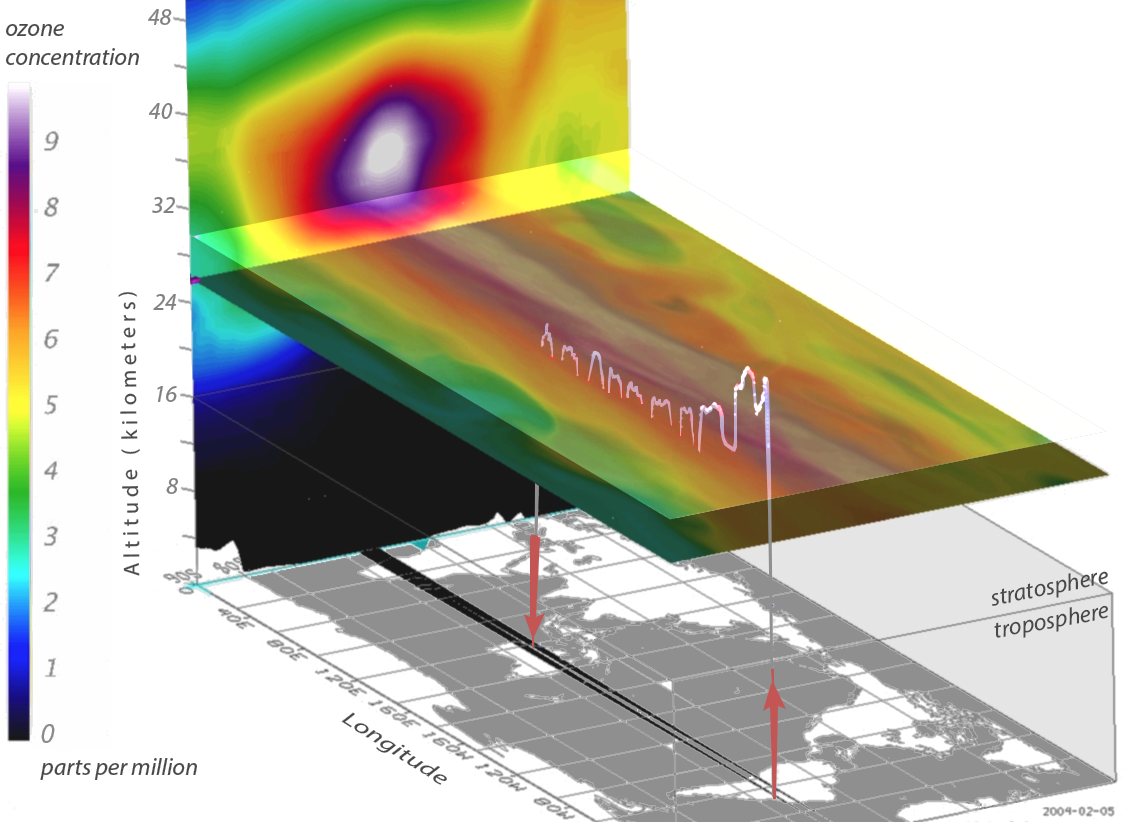
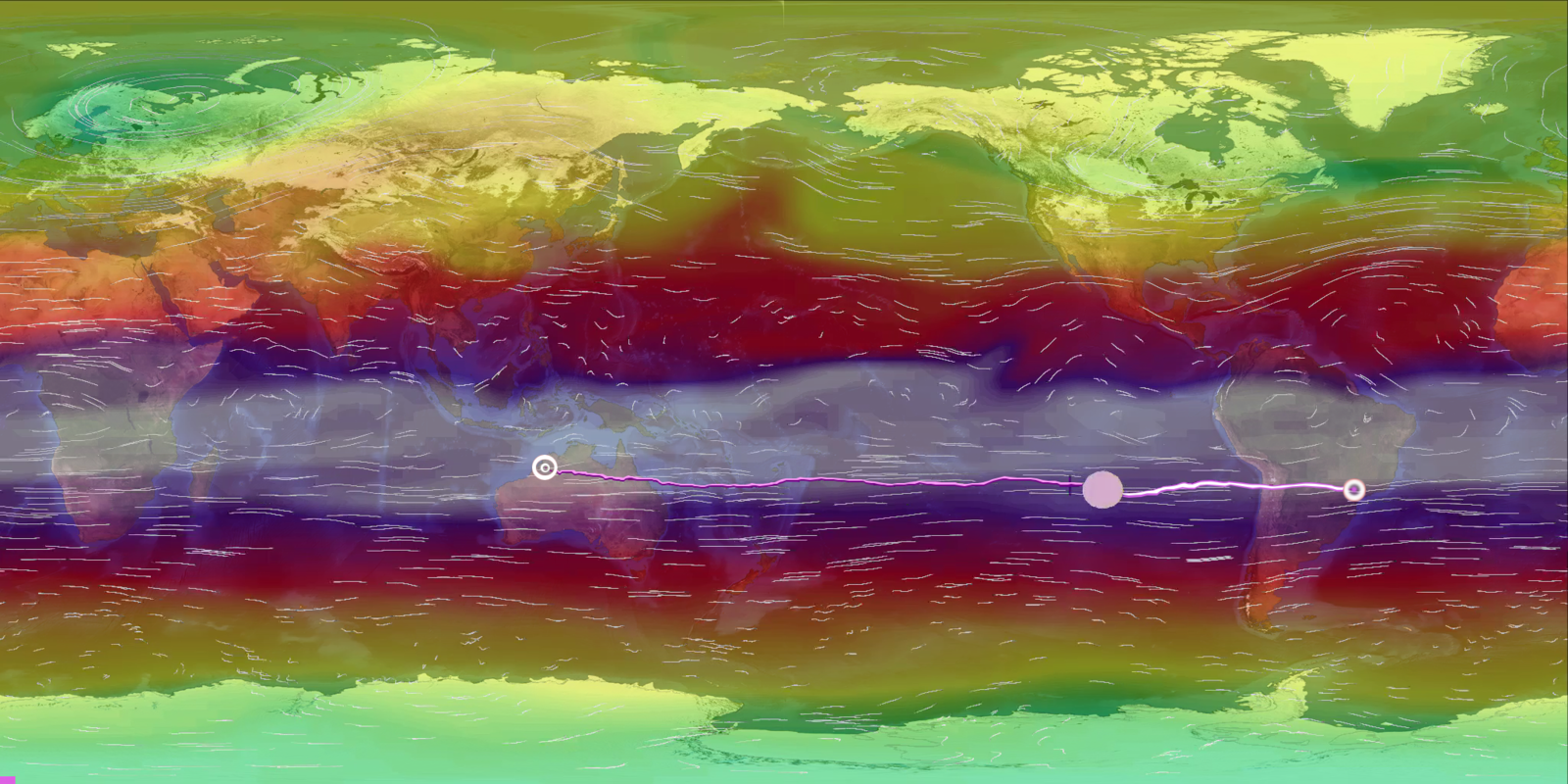
MIR flight and ozone (February, 2004)
1960
1999
plan cut at 37 mb

zonal-average xsect
Looking to the future
When and where would it be best to launch a balloon, perhaps one of Saraceno’s? How do we choose? To get a better idea, it is important to check the climatological distribution of the wind throughout the year. Fig.5 shows isosurfaces of the zonal wind in January (left) and July (right): inside this surface, the wind speed is greater than 25 meters per second.
It is clear that in the Northern hemisphere flow tends to be strong and mostly toward the east in winter. A band of flow from east to west tends to dominate the tropical atmosphere, but its location shifts with the seasons as the Hadley Cell migrates across the equator.

Hovmöller diagrams at various pressure levels, as in Fig. 6, can help us choose an appropriate time of the year to launch a balloon along specific tracks. To repeat flights from Brazil to Australia in the stratosphere, we should choose a month between January and March, because then the flow is strong east to west. In fact, several MIR flights in the tropical stratosphere were launched from Brazil in February (Fig. 2), or Ecuador in March.
Similarly, let’s suppose we want to fly a balloon from Boston to Paris: when would a launch lead to the fastest travel time? We find that it is also best to launch in January to March, when the flow from west to east at the jet level (250 mb) is very strong, as can be seen in Fig. 6 (right).
Climatologic spacetime

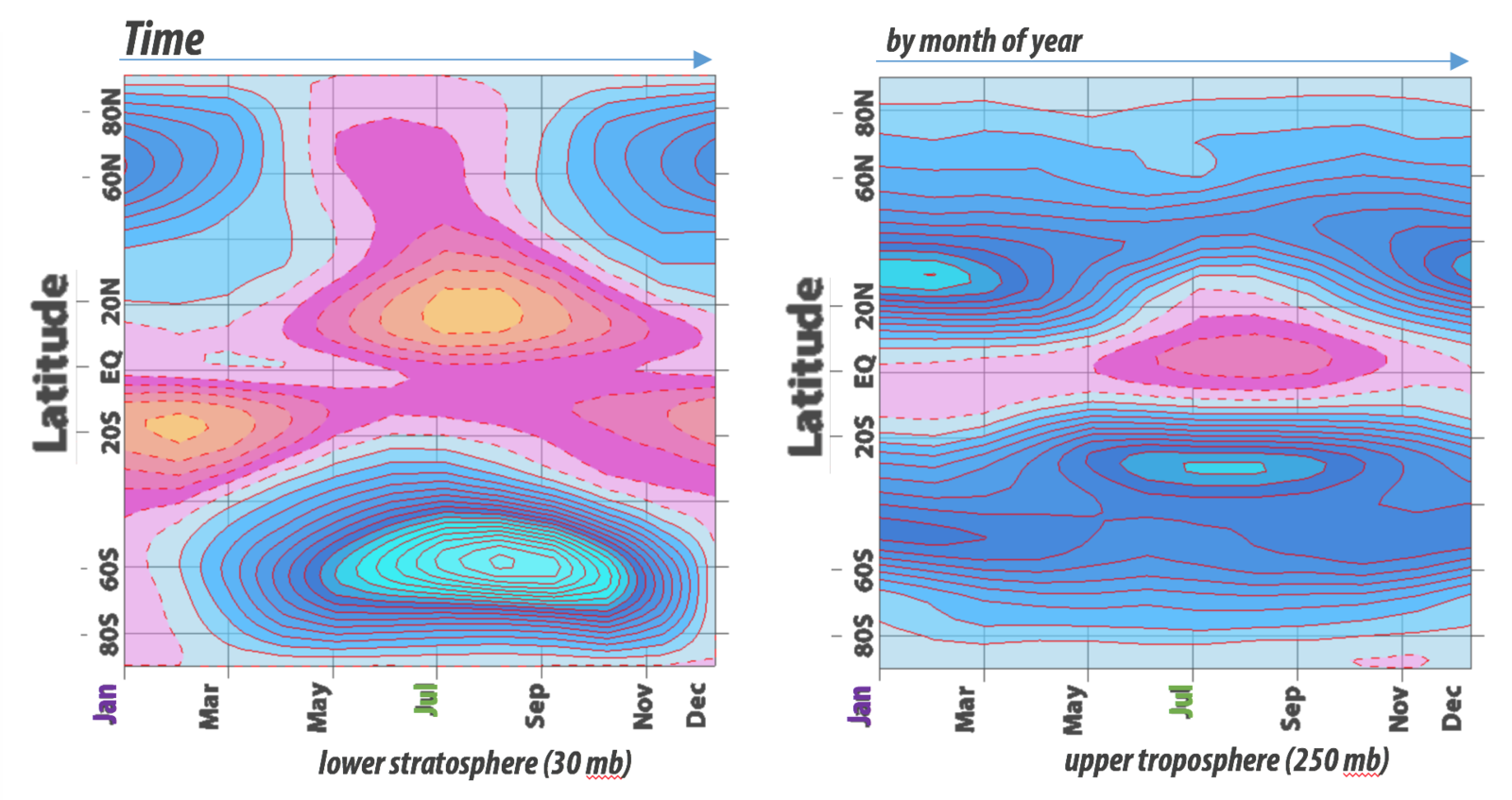

Trajectories from current forecast data for the stratosphere
If we were planning to launch a balloon out to the stratosphere from South America now, in October 2015, as we write this article, where might it be carried by the prevailing winds? We can use the NCEP global model forecast data3 to figure this out. Fig. 7 shows typical trajectories at 30 mb starting from different locations over South America. It is clear a track from east to west is dominant from tropic to mid-latitudes, whereas at high latitudes and close to the equator, tracks progress from west to east.

Trajectories from current forecast data for the stratosphere
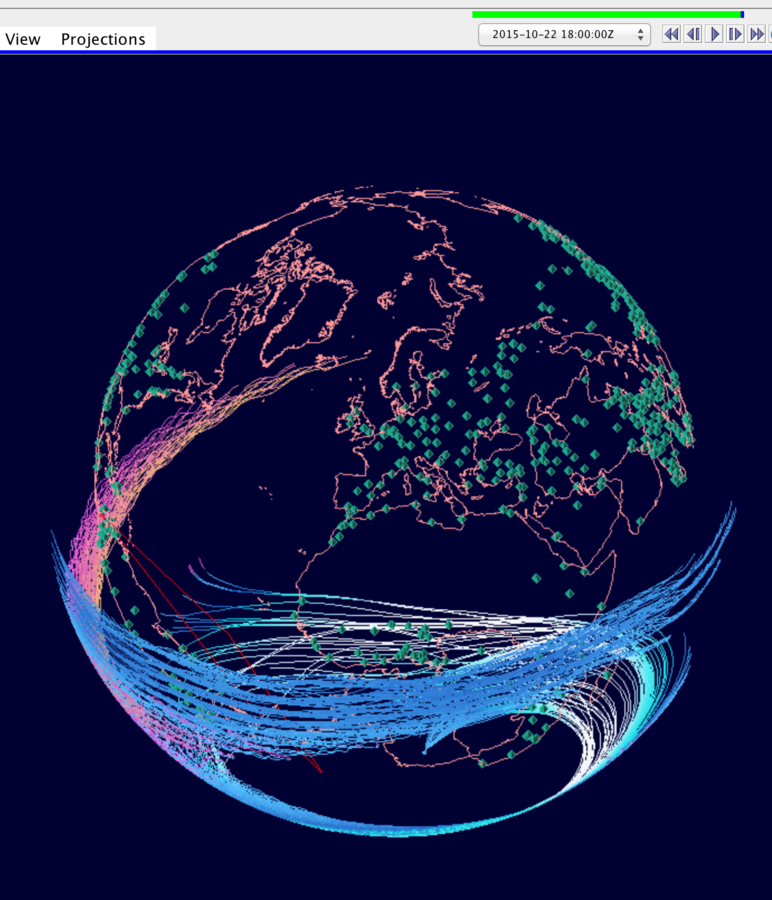
For fun, we consider flights to Paris by balloon at the tropospheric jet stream level. At this time of year (October), what air currents are already en route? When is best to catch a ride?
To find out, we have computed backward trajectories for 5 days starting at locations near Paris in western Europe – see Fig.8.
In October, the flow is typically not very zonal, and therefore, it is not surprising that we might reach Paris in 5 days starting from very different locations over the US: for example, Texas, the East Coast or even the Caribbean Islands.
Trajectories from forecast data in the troposphere – circulation to Paris
Trajectories from forecast data in the troposphere – circulation to Paris
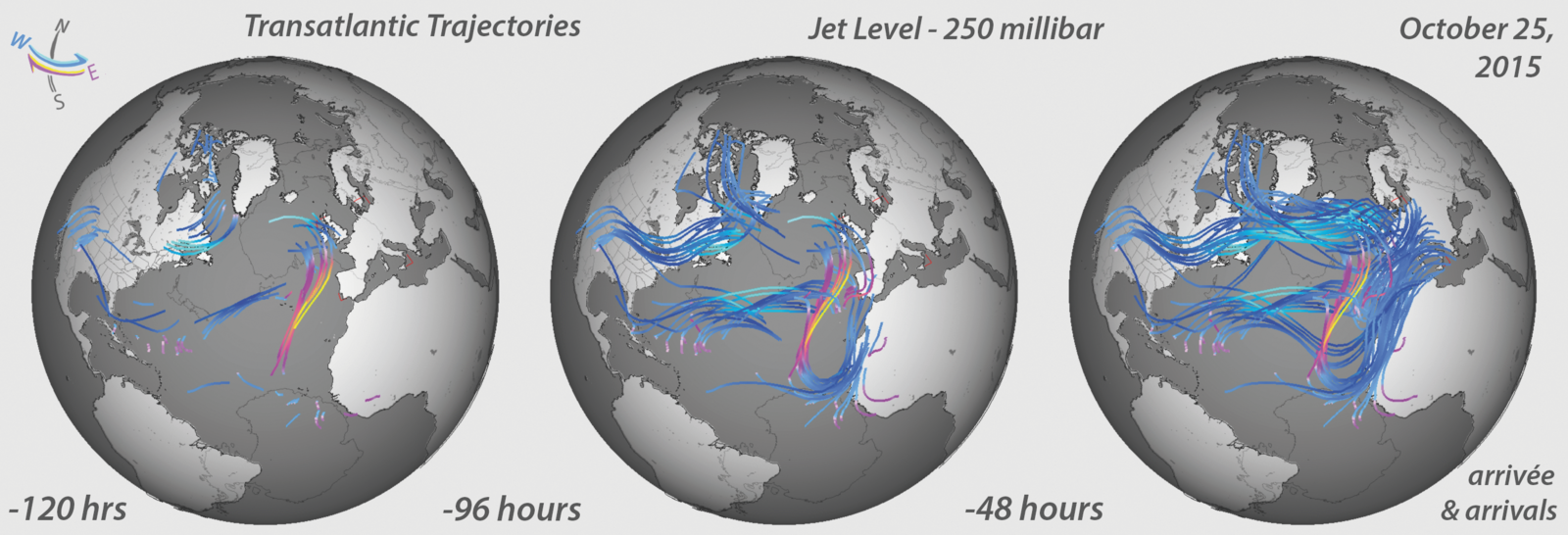

Summary
Tomás Saraceno’s vision of flying solar balloons between cities might be rather futuristic, but such technology could be used to sense the lower stratosphere at almost zero energy cost. The lower stratosphere is a critical layer where the chemistry of ozone, methane and other chemicals has a fundamental impact on our climate. Concentrations of these chemicals are not well known and there is a clear need to better monitor these constituents. We could imagine having a large array of solar balloons, moving with the flow, and measuring constituents all over the stratosphere.
Because the balloons need IR radiation at night, there are only limited regions on the earth where the balloons can stay up for a long period. These are mainly the regions of sinking of the Hadley cell where there are no clouds. This is a limitation at the moment but we feel that it is worth revisiting the possibilities of flying solar balloons again to measure the stratosphere more accurately than has been done in the past.
The IR/solar balloons could be the answer. With their low energy consumption, they are the best example of green technology for atmospheric sensing!
Continue right to ride the jets !
↓ dive out to references ↓
References
[1] CNES (MIR)
Montgolfière InfraRouge - http://cnes.fr/fr/web/CNES-fr/9276-mir-principes-du-vehicule.php
Letrenne et al (1999): French Long Duration Balloon Activity: The Infrared Montgolfière (MIR), Proceedings AIAA International Balloon Technology Conference, 28 June – 1 July, 1999, Norfolk, VA.
[2] MIT (EAPS)
John Marshall, Susan Solomon, Lodovica Illari Frontiers in Earth System Dynamics: NSF-funded project on the climate implications of the ozone hole http://ozoneandclimate.squarespace.com/
[3] NCEP (Global Forecast System)
GFS - http://www.emc.ncep.noaa.gov/
[4] UCAR (Unidata)
Unidata’s Integrated Data Viewer[4] was used for most of the plots. NCEP Reanalysis data provided by the NOAA/OAR/ESRL PSD, Boulder, Colorado, USA via THREDDS
Acknowledgments
Lodovica Illari acknowledges support from the Frontiers in Earth Science Dynamics (FESD) ‘Ozone and Climate Project’[2] of the National Science Foundation (US).
Bill McKenna acknowledges support from MIT Center for Art, Science & Technology (CAST) and Prof. Glenn Flierl (EAPS).
Tomás Saraceno is a Visiting Artist with CAST since 2012.
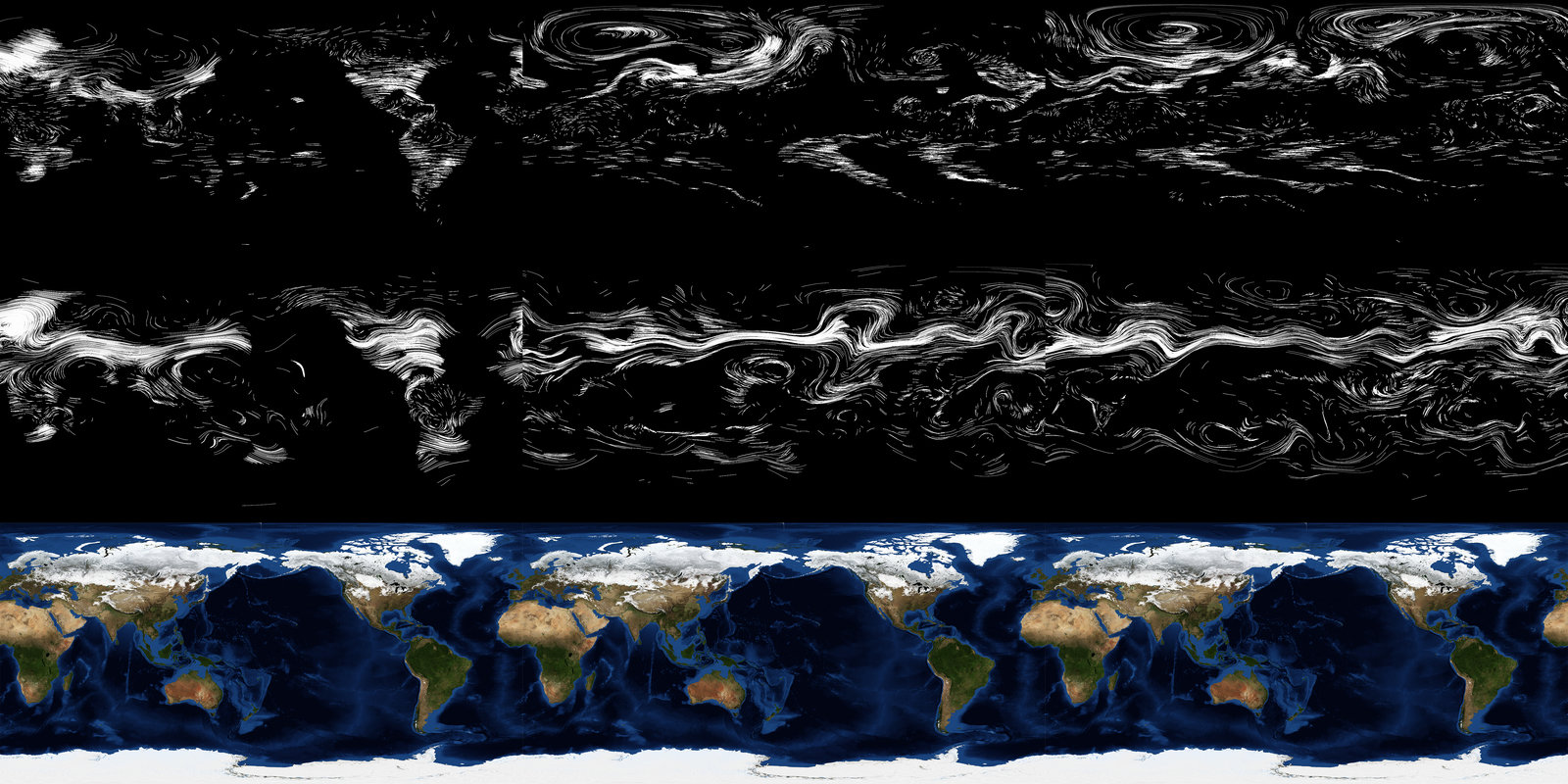
journey from B to A
through a MIR in past
ozone ups & downs
by air to paris in reverse
falling in spring 2004
the average of 30 years
your summer or winter windsrising in fall 2015
aero.solar
[ESC or pinch for an overview effect]
Index of Figures
Introduction
One of the oddest sensations of hot air balloon flight is the feeling of absolute stillness and extreme quiet. A paradox: moving with the wind eliminates the feeling of wind and thus a feeling of movement. Tomás Saraceno is fascinated by – or, more accurately, creatively obsessed by – airborne movement of all kinds, from the astonishing phenomenon of “kiting” spiders that create parachutes of gossamer silk, catch updrafts and drift through the jet stream to propel themselves hundreds of miles from land, to the ongoing series of prototypes for floating biospheres fueled by wind and solar heat that he has created for more than fifteen years, Air-Port /Cloud-Cities. They are speculative models for alternate ways of living – and alternate ways of flying. Saraceno would like to propose zero-carbon emission flight; make your reservations now for Aerosolar Airlines, as he has been known to say!
As the inaugural Visiting Artist for MIT’s Center for Art, Science & Technology (CAST), beginning in Fall 2012, Saraceno brought these multifaceted interests into creative dialogue with multiple departments across the Institute. Moving among practical, theoretical and hypothetical considerations, Saraceno discussed everything from nanoengineered materials to solar energy to weather patterns to the origins of the universe, asking architects, engineers and scientists in diverse fields to imagine with him what a different reality might look like. A wide-ranging foray into disparate areas of expertise led Saraceno to develop a productive collaboration with Lodovica Illari, a climatologist whose specialty is large scale atmospheric dynamics, and Bill McKenna, whose architectural training led him to her EAPS (Earth, Atmospheric and Planetary Sciences) lab to work on visualizations of geophysical fluid dynamics. Sharing a mission “to make people understand what is not intuitive” (her words), they began with “Weather in a Tank,” a series of rotating fluid laboratory experiments created by Illari and Professor John Marshall.





... Aerocene is the latest node in Tomás Saraceno’s continuous experimentation with solar balloons, which include his own do-it-yourself versions, (e.g., 59 steps to be on air by sun power, 2003), crowd-sourced variations made with plastic shopping bags (Museo Aero Solar, ongoing since 2007,) and a residency at CNES (Centre Nationale d’Études Spatiales), spent immersed in studying their MIR (Montgolfière InfraRouge) solar balloon flights. Now Illari and McKenna have used the MIR flight data to visualize the possibilities for a new series of solar balloons that could monitor the chemical components of the stratosphere and measure their effect on climate change. But there is more than a gathering scientific data in the offing. In keeping with his capacity to work at multiple scales, modes of expression and registers of engagement, Saraceno also sees these balloons as “lighter-than-air sculptures” and as an opportunity for a highly distributed network of participants to monitor their progress, predict the weather collectively, and raise awareness of our technological disruptions of planet Earth. The scenarios outlined below link technical expertise to visionary thinking and material realities to a future “jet stream art research center” – “Cloud Cities” in the making.
↓ dig down for a fuller introduction ↓
cut loose
becoming aero.solar ↭ worldwideweb
By ment
becoming aero.solar ↭ worldwideweb
an MIT EAPS CAST animated exploration, building firm foundations for the opening aerocene project by Tomás Saraceno. the fuller publication distributed @ 'Solutions COP21' event is available for download in digital format: http://www.aerocene.com/newspaper/
- 40,043

















